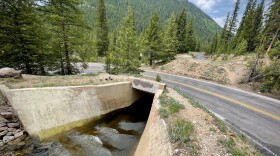The fall and winter are usually pretty quiet times for Colorado’s rivers. Gone are the high flows of spring and the tubers enjoying a lazy summer float. But in northern Colorado, October breathes a short burst of new life into the Cache la Poudre River.
It all has to do with the river’s role as a conduit for sending water from reservoirs in the foothills to farms and power plants downstream. One of the area’s most important water management calendars runs from November 1 to October 31, meaning that some water users are requesting their final end-of-year deliveries from Horsetooth Reservoir in the last few weeks of October.
As of about 2 p.m. on Friday, October 20, flow levels near downtown Fort Collins had already risen above 200 cubic feet per second (cfs). That’s more than double the previous 30-day high of 80, set on September 21. It’s 65 times higher than the 30-day low of about 3 cfs. Prior to the release, water levels had not gone above 200 cfs since August 4.
The additional water rushing through the Poudre late this month is mostly from the Colorado-Big Thompson Project. It’s a network of pipes, tunnels, canals and reservoirs that carries water from the western slope to the other side of the mountains. Most of it starts as snow on the West side of Rocky Mountain National Park. From there, it’s sent through a tunnel underneath the park, then deposited in Horsetooth Reservoir.
Throughout the summer, farms, ranches and industrial water users order water in accordance with their legal allocations, and it’s sent downstream through the Poudre until it reaches smaller reservoirs to be stored near the places it's used.
This October burst of water is mostly going east of Greeley, to reservoirs on the South Platte River, where it's mainly used for agriculture. Some water will also be used by power plants in Morgan County.

In Colorado, about 80% of the state’s water falls on the west side of the mountains, but 80% of its people live on the east side. The development of big cities and suburbs in Colorado, as well as much of the West, is partially made possible by a number of massive engineering projects that carry water across great distances and mountain ranges.
That large-scale plumbing system contributes to demand on the Colorado River, and has prompted environmentalists to criticize new reservoir and pipeline projects as added burdens on an already-strained water source.
Northern Water, the agency which co-manages the Colorado Big-Thompson Project and delivers its water to communities along the northern Front Range, says this highly-engineered system of moving and storing water is necessary to bring it to homes and businesses when the melting snow of spring and summer is gone, leaving rivers low during the autumn and winter.
“If you decide to live on the northern Front Range of Colorado, you're really making the deal that you need reservoirs in order to practice your daily life,” said Jeff Stahla, a spokesman for Northern Water. “What we've realized over 150 years of living here is that re-timing water is what allows us to have modern life and modern cities on the Front Range.”
Stahla said this year’s burst of October water should only last a few days. While it’s happening this fall, it isn’t guaranteed to occur every year.
This story is part of ongoing coverage of the Colorado River, produced by KUNC and supported by the Walton Family Foundation.





